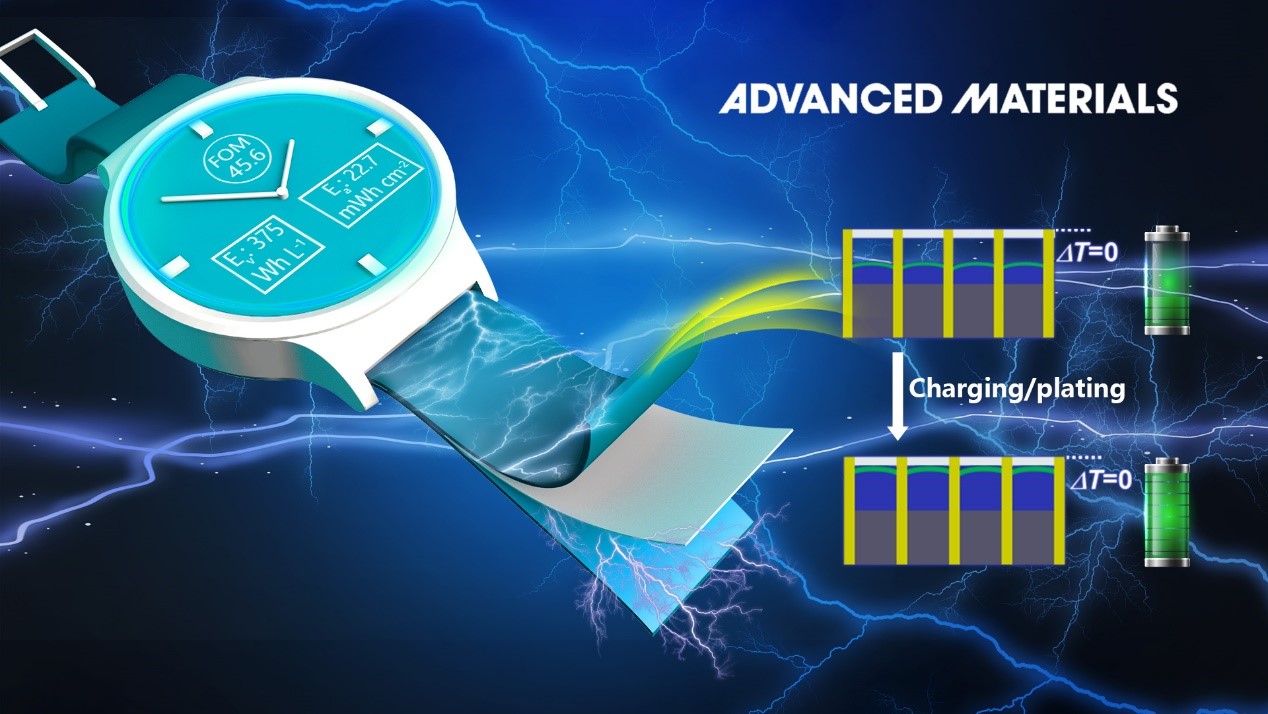A wide variety of applications ranging from electric vehicles and portable devices to wearable devices impose ever-increasing demand for high-energy-density battery technologies. Due to the lowest electrochemical potential and the highest theoretical specific capacity, lithium (Li) metal has been recognized as the ultimate choice of anode to achieve high-energy-density battery systems.
Despite the appealing properties, hostless Li metal usually suffers from unacceptable volume expansion, which further causes the random deposition of Li dendrites and the rupture of solid electrolyte interphase (SEI), leading to rapid capacity degradation and potential shorting hazards. Moreover, large volume expansion of Li metal during cycling also induces the continuous increment of electrode thickness and interfacial stress between the electrodes and the separator, resulting in cell bulge and structural failure.
These consequences of volume expansion become even more notorious in flexible batteries because the soft aluminum-plastic packaging layers cannot withstand an atmospheric expansion pressure (~100 kPa). Therefore, the volume expansion and dendritic deposition of Li metal anodes must be resolved before they can be practically used in the industry.

Professor Yonghong Deng’s research group from the Department of Materials Science and Engineering (MSE) at the Southern University of Science and Technology (SUSTech) recently proposed a novel design and scalable fabrication of zero-volume-expansion lithium composite anodes with high electrochemical and mechanical stability through simple roll-to-roll manufacturing processes.
The sandwich-like trilayer structure of zero-volume-expansion lithium composite anodes could simultaneously suppress the dendrite formation, eliminate volume change during cycling and provide excellent mechanical robustness. The zero-volume-expansion structure design of lithium composite anodes enables the outstanding electrochemical and mechanical stability of high-energy-density lithium metal batteries.
Their research, entitled “Roll-to-roll Fabrication of Zero-Volume-Expansion Lithium Composite Anodes to Realize High-Energy-Density Flexible and Stable Lithium Metal Batteries,” was published online in Advanced Materials, a high-profile journal in material science.
In this study, the researchers report a novel design of a robust zero-volume-expansion Li metal composite anode (zeroVE-Li) for high-energy-density LMBs with excellent electrochemical and mechanical stability. By employing the one-step roll-pressing method, the zeroVE-Li was readily fabricated by embedding an electron-insulating mesoporous polymer layer and a lithiophilic alloy layer into the upper and bottom sides of an ultrathin metalized carbon fiber mat.
The upper electron-insulating layer and the bottom lithiophilic layer could coordinately promote the deep migration of Li-ion and bottom-up deposition of uniform and dense Li metal inside the zeroVE-Li. Notably, the middle porous layer not only eliminates the volume expansion of the zeroVE-Li during repeated plating/stripping processes but also improves the mechanical flexibility during various mechanical deformations.

Figure 1. a) Schematic of the one-step fabrication process and working principle of zeroVE-Li). b) The volume expansion behaviors of zeroVE-Li, LiMg/CuCM/EI, and bare LiMg anodes during repeated plating/stripping processes. c) The cell pressure changes of Li metal cells with zeroVE-Li and LiMg during repeated plating/striping processes under fixed initial external pressures (70 and 140 kPa). d) The maximum cell pressure changes of cells with zeroVE-Li and LiMg during the plating process with increasing external pressures. e) Galvanostatic plating/stripping profiles of symmetric cells based on various Li metal anodes in carbonate electrolyte. f) Cycling stability of high-voltage Li metal full cells by pairing various Li metal anodes with high-mass-loading NMC811 cathodes.
The zeroVE-Li addresses the uncontrolled volume expansion and significantly improves the stability of Li metal anodes by introducing a sandwich-like composite structure. As a consequence, flexible LMBs made with the zeroVE-Li offer a record-breaking FOM value (45.6), high volumetric energy density (375 Wh L-1, based on the volume of the anode, separator, cathode, and package), high capacity retention (>99.8% per cycle), and remarkable bending stability, under a practical condition of a low N/P ratio (2.2) and lean electrolyte (3.2 µL mAh-1).
The zero-volume expansion design provides a new solution for the practical application of lithium metal batteries. The roll-to-roll fabrication process of zeroVE-Li shows its high potential for large-scale manufacture. In principle, the zero-volume-expansion design is also applicable to constructing other metal battery anodes (e.g., sodium, potassium, and zinc metal batteries, etc.) to enhance their high energy density and cycling stability.

Figure 2. a) Normalized sheet resistances of Li metal anodes (zeroVE-Li and LiMg) as a function of bending cycles (bending rate = 10 mm s-1). b)Areal capacities of Li metal full cells with zeroVE-Li and LiMg are recorded during repeated bending processes. c) Charge/discharge curves of Li metal full cells with zeroVE-Li during dynamic flexing cycles. d) Voltage output of single-pair Li metal full cells with zeroVE-Li is recorded as a function of operation time during repeated dynamic bending processes. Insets are optical images of the single-pair zeroVE-Li cell powering a large light-emitting diode screen. e) Areal capacities of tandem Li metal full cells are recorded during both electrochemical and mechanical bending cycles. f) Comparison of the volumetric energy densities, bending radiuses, and bending cycles between our zeroVE-Li full batteries and previously flexible lithium-based batteries.
Chao Luo, a Ph.D. student from the Department of MSE at SUSTech, is the first author of this paper. Professor Yonghong Deng, Research Assistant Professor Jian Chang from SUSTech, and Professor Zijian Zheng from the Hong Kong Polytechnic University (PolyU) are the corresponding authors.
This research was supported by the Key-Area Research and Development Program of Guangdong Province, National Natural Science Foundation of China (NSFC), Guangdong Basic and Applied Basic Research Foundation, Science and Technology Planning Project of Guangdong Province, and Science, Technology and Innovation Commission of Shenzhen Municipal.
Paper link: https://doi.org/10.1002/adma.202205677
To read all stories about SUSTech science, subscribe to the monthly SUSTech Newsletter.